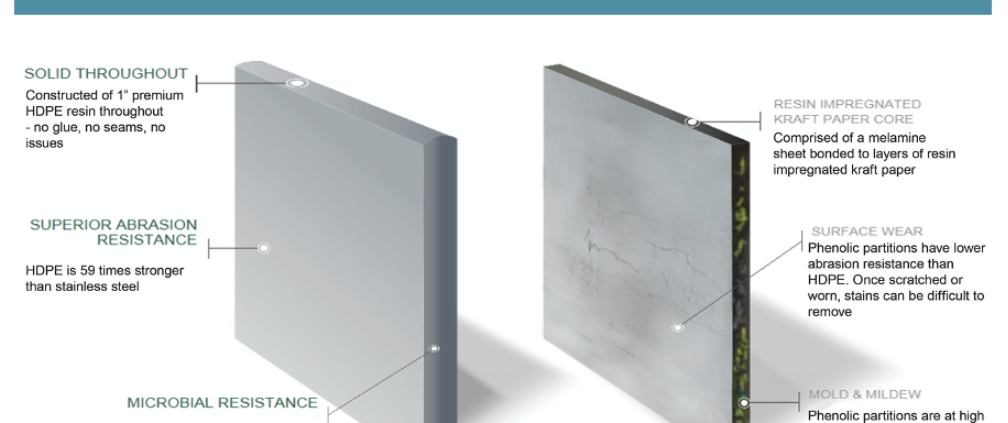HDPE vs Phenolic Toilet Partitions
When it comes to bathroom partitions, your options are limited. There’s metal and then there’s plastic. So how do you know which material is the best fit?
In this article, we compare HDPE (high-density polyethylene) vs. phenolic toilet partitions, two of the most popular materials on the market, so you can see how they stack up. We’ll also help you decide which material is right for your next remodel or construction project.
HDPE vs Phenolic Material Comparison
HDPE features solid plastic with color throughout. When the 1-inch-thick panels are configured into a standard toilet partition, it weighs about 165 lbs. Phenolic, on the other hand, is resin-impregnated kraft paper, featuring ¾- and ½-inch panels and pilasters.
Many people have the misconception that HDPE and phenolic toilet partitions are made from the same material. However, this couldn’t be further from the truth.
HDPE is made of high-density polyethylene resin and pigments. Phenolic partitions, on the other hand, are made of a melamine sheet and many layers of resin-impregnated kraft paper. When it comes to the harsh conditions that can be found in commercial restrooms, HDPE offers additional performance in microbial resistance, surface durability, sustainability, and cost of ownership.
Let’s take a closer look at those categories now.
Microbial Resistance of HDPE and Phenolic Partitions
Resistance to mold and mildew is an important quality when talking about commercial bathroom partitions. Moisture is certainly abundant, and porous surfaces are most at risk.
In a controlled scientific test, we found that HDPE was 100% resistant to mold and mildew. Meanwhile, phenolic took only 21 days to begin showing signs of mold and mildew growth. By day 28, that number continued to rise.
Comparing Surface Durability
Public restrooms can undergo heavy use, and their ability to stand up to normal wear and tear is essential for keeping operating costs down. When it comes to abrasion resistance, HDPE comes out on top compared to phenolic toilet partitions. Phenolic experiences higher surface wear, which indicates a lower resistance to abrasion. This wear could come from normal handling, cleaning, or polishing.
What’s more is that once the surface of the phenolic toilet partition has been worn or scratched, it may be more difficult to remove stains or a ghosting effect could occur.
Sustainability
It’s no secret that HDPE is 100% recyclable, but did you now that it’s also available in 100% post-consumer content? Phenolic, on the other hand, isn’t recyclable and it’s not available in any amount of post-consumer content.
HDPE partitions are also low-emitting materials and free of added urea-formaldehyde resins. Phenolic partitions can’t say the same.
Cost of Ownership
One of the most important factors that designers consider when sourcing materials is the cost of ownership. HDPE partitions have a relatively low initial cost and even fewer long-term costs when you consider its impeccable durability. Meanwhile, phenolic partitions may cost you more upfront and require additional long-term costs compared to HDPE.
About Scranton Products
Scranton Products is the leading manufacturer of HDPE bathroom partitions in North America. Our HDPE partitions are distributed through one of the largest distribution networks in the industry.
Click here to learn more about Scranton’s toilet partitions.



